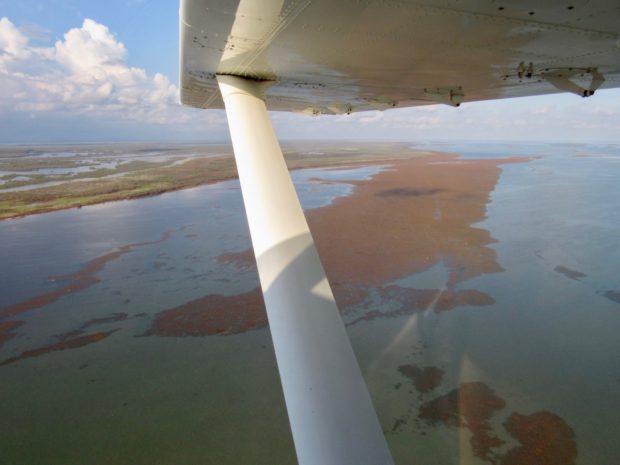We have much more to do and your continued support is needed now more than ever.
Restoring Paradise After Hurricane Irma

Florida has always been in the path of storms – it juts right out into Hurricane Alley – but as people have built along the coast, drained wetlands, and contributed to a warming climate, the state has become more vulnerable to storms that are increasingly more severe.
Land by the Gallon
Florida’s history of reshaping the landscape began nearly as soon as it became a state. People drained what was seen as “useless swamp” to pave the way for “paradise” in the form of coastal developments and farms. America’s Everglades were ground zero for this assault on wetlands. The Everglades’ historic patchwork of estuaries, cypress swamps, pinelands, and sawgrass marshes once covered more than 3 million acres – flowing from headwaters in the Kissimmee River and spilling over Lake Okeechobee’s brim south to Florida Bay. Now, less than half of this historic ecosystem remains.

The centuries of draining Florida’s wetlands have made communities, habitat, and wildlife more vulnerable to floods, storms, sea level rise, and droughts. Instead of capturing water during summer storms and storing it for use during droughts, now water gets sent to all the wrong places. The result: an economic and ecological nightmare in three coastal estuaries that Florida can’t seem to wake up from. Too much polluted fresh water drowns the Caloosahatchee and St. Lucie estuaries, sliming coastal beaches with thick, smelly algae. Too little water reaches the thirsty Florida Bay, causing massive sea grass die-offs in the estuary that fuels much of South Florida’s fishing economy.
The very quality that makes South Florida so special – for anglers, tourists, and locals alike – is the same thing we’ve disrupted: water. Water feeds Everglades National Park, bringing at least one million wildlife watchers, campers, kayakers, and hikers to the region each year. The Everglades provides the drinking water supply for 1 in 3 Floridians. Florida Bay’s estuary is dependent on freshwater inflows from the Everglades, which in turn ensures the continued health of the sport-fishing capital of the world – the Florida Keys.
Hurricane Irma’s Impact on Florida Bay

Everglades Foundation.
Though it’s too early to understand the full extent of Irma’s impacts on the Everglades, Dr. Stephen Davis, a wetland ecologist with the Everglades Foundation, recently flew over Florida Bay to survey the damage left in Irma’s wake. The most troubling impacts visible were mats of uprooted seagrass floating in Florida Bay as far as the eye could see. This is particularly concerning since the bay is still struggling to recover from a drought-triggered seagrass die-off in 2015, that killed more than 40,000 acres of turtle grass, and subsequent algal blooms in 2016. When a seagrass collapse of this magnitude happens, it has lasting impacts on the bay, weakening an already delicate system. More dead seagrass in Florida Bay could fuel algal blooms and kill fish, as the seagrass decomposes in the heat of summer.

Also evident was the extent of Irma’s wind damage and evidence of up to five feet of storm surge in the Glades’ freshwater mangroves and marshes. Mangroves lining Shark River in Everglades National Park were visibly stripped of their leaves. South Florida’s mangrove forests help protect the coast against storms, maintain water quality, and reduce flooding. They thrive where saltwater mixes with freshwater, so, when storm surge pushes saltwater inland, it disrupts the delicate salinity balance upstream. This, coupled with wind damage and already reduced mangrove forests due to coastal development, could impact their ability to recover and protect the shoreline against future storms and flooding.

Irma’s rains raised Lake Okeechobee levels to almost 16 feet above sea level, and they’re expected to continue to rise to 17 feet. The Army Corps tries to maintain lake levels between 12.5 and 15.5 feet above sea level by flushing freshwater through the St. Lucie and Caloosahatchee Rivers to alleviate pressure on the aging dike. The influx of rapidly-pumped polluted, nutrient-rich water could harm the delicate estuaries and corals on Florida’s east and west coasts. Additionally, high lake levels can negatively impact lake vegetation, which is critical habitat for Okeechobee’s famous largemouth bass and black crappie fisheries.

Wetland loss, coupled with sea level rise, makes Florida’s residents and wildlife more vulnerable to storms. The Miami area, which borders the Everglades on Florida’s east coast, has seen a sharp increase in “sunny day” flooding, when streets flood simply because of high tide. We’ve reengineered a landscape that can no longer store water the way it was designed to.
Everglades Restoration Means a More Resilient Florida

The solution to strengthening Florida’s communities and wildlife for future storms? Getting the water right. The best tool to improve resiliency in South Florida is Everglades restoration. The Central Everglades Plan (CEP) aims to reconnect the system in a way that sends water south, more closely mimicking the historic way it moved throughout the Everglades. As CEP is implemented and more water is sent south, we must simultaneously increase water storage capacity south of Lake Okeechobee, a critical piece to get the Everglades and Florida Bay off life-support. Constructing the Everglades Agricultural Area reservoir will help capture and store water when there’s a lot of it, and allow us to draw from it in times of drought. Sending water south will also help increase the resiliency of coastal wetlands and estuaries against the effects of storm surge and saltwater intrusion, by preventing saltwater from pushing as far inland.
There have already been several historic storms this hurricane season, and it’s not over yet. As we rebuild in the wake of these storms, it is critical that we implement nature-based natural infrastructure and common-sense policies that help make our coastal communities more resilient. Comprehensive Everglades restoration is a critical part of rebuilding a resilient Florida in the wake of Hurricane Irma.
Take Action





















